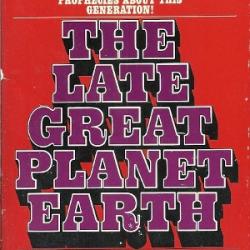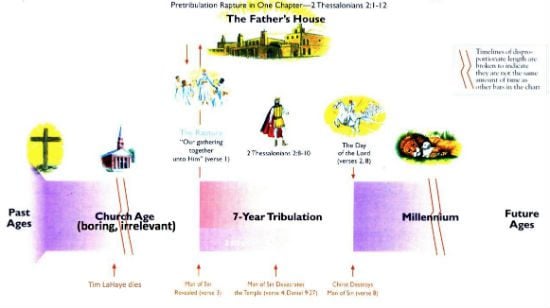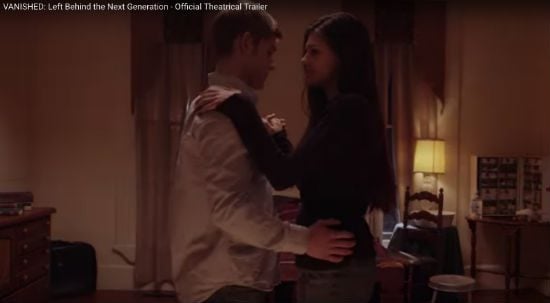Left Behind, pp. 109-114
The manager of the Midpoint Motel is named Mack. I wish I had been there to make the introductions when Buck Williams checked in: Buck, Mack. Mack, Buck.
Left Behind offers no account of this initial meeting, nor any explanation of why Buck didn't make arrangements to pay for the room while he was there at the front desk. He takes care of that later — on the telephone. Despite the fact that the two men couldn't be more than 50 yards apart, Buck seems more comfortable negotiating even such an elementary patron-clerk conversation by phone. Again we have to wonder, is this some social phobia? Is it a fear of intimacy that seeks a mediating buffer of distance and technology for interaction with others? Or is it just bad writing?
That last is most likely, so take a moment again to marvel at the financial success of Jerry Jenkins' side project running writers workshops. A generation of young writers, one assumes, is being taught that telephone is the key to writing dialogue. Look for one of Jenkins' students to break new literary ground with an epistolary novel composed entirely of text messages.
Buck goes to sleep at the motel watching CNN and musing, for the first time, and in only the most general terms, about the scope and the meaning of the disappearances:
He turned CNN on low so it wouldn't interrupt his sleep, and he watched the world roundup before dozing off. Images from around the globe were almost more than he could take, but news was his business. He remembered the many wars and earthquakes of the last decade and the nightly coverage that was so moving. Now here was a thousand times more of the same, all on the same day. Never in history had more people been killed in one day than those who disappeared all at once.* Had they been killed? Were they dead? Would they be back?
Buck earlier told his father that he has already filed stories on the disappearances — although it's not clear when that happened (perhaps during his long reverie in the O'Hare men's room). But any such story would have required a lead sentence that answered, or at least addressed, the basic questions that every reporter is trained to ask, and that any halfway competent editor would demand: Who? What? When? Where? Why?
People disappeared. Who, exactly? Or, at least, who generally? How many? When? The reader has no better idea of the answers to these questions than Buck does, and LaHaye and Jenkins seem to think the reader should be, like Buck, contently incurious about such things.
L&J have not made it easy to puzzle out when the disappearances occurred. We know it was nighttime over the Atlantic, and that back in Chicago it was after Irene Steele's bedtime (which, based on what we know about Irene, could be 8:30 on nights there's no prayer meeting). Would it have been too much to ask for someone to have glanced at their watch? Or at least at a calendar? We're a 100+ pages in and we still don't know what day of the week or time of the year it is.
In an earlier post I took a stab at a ballpark estimate of the number of disappeared. It's not possible to know how many of the world's 1.8 billion Christians make the cut when it's L&J, and not Jesus, separating the sheep from the goats. Guessing that at least half of those make the grade, and adding everyone who's allowed to order from the children's menu, gives us a total of about 2.25 billion people, or about 37 percent of the world's population.
Nothing could be scripted like this, Buck thought, blinking slowly. If somebody tried to sell a screenplay about millions of people disappearing, leaving everything but their bodies behind, it would be laughed off.
L&J wrote this in 1995, four year's after Michael Tolkin's "The Rapture" and a year after the broadcast of a miniseries based on Stephen King's "The Stand." But let that pass — the problem with this paragraph is that it says "millions" instead of "billions." Again, L&J haven't given even a cursory second thought to what it means for every child under the age of 12 to disappear.
Whatever the precise figure of the disappeared, however, we can safely assume that it included hundred of thousands, if not millions of young, attractive white women. Buck is watching CNN. Think of it: Millions of missing white women, all at the same time. What would CNN do? Would they cover them all? Or maybe just the blonde ones?
Rayford Steele, meanwhile, is shuffling around his living room, periodically hitting redial on his phone. He finally gets through to his daughter's Stanford dorm room and learns from her roommate that Chloe is on the road, "trying to find a way back there."
"She'll try to call you along the way, sometime tomorrow," the roommate says. "If she can't get through, she'll call you when she gets there or she'll get a cab home."
A cab home from where? From Palo Alto to Chicago? That's a hell of a fare. Chloe does, in fact, arrive in a cab about 40 pages from now. It's apparently a local cab. There's no explanation of where she grabbed this cab or how she got from California to Illinois.
It seems like she's taking a cab from the airport. You know, the airport that's shut down. The airport where one of our main characters is a pilot who is now idle at home because no planes are flying. The airport that our other main character fled in order to charter an expensive private flight to New York because no planes are flying. That airport. Chloe apparently flew there. On a plane.
Rayford picks up a newspaper to help himself fall asleep. He remembers here what the authors forgot earlier (see "Yesterday's news") — that this paper went to press before the disappearances: "It should be interesting to read the meaningless news of a world that didn't realize it was going to suffer the worst trauma in its history just after the paper had been set in type."
Rayford lay in bed several minutes, then idly thumbed through the first section of the paper. Hmm. A surprise move in Romania.
That paragraph makes me laugh every time. In a book that offers so much unintentional hilarity, that may be my favorite paragraph.
It is here, in this awkwardly shoehorned-in piece of exposition, that we read the description of Nicolae Carpathia as "a strikingly handsome blond who looked not unlike a young Robert Redford."
We'll be seeing a lot more of Sundance in the pages to come. L&J's prophecy agenda dictates that the Antichrist's rise to power must now eclipse any further consideration of the rapture's aftermath. This means that more and more people in the coming pages will, like Rayford, begin to think: "Forget about those billions of missing children, what's this going on in Romania?"
– – – – – – – – – – – –
* I would have guessed that the deadliest day in human history was August 6, 1945, but this Wikipedia list of death tolls suggests that the bombing of Hiroshima may not even be among the Top Ten. The deadliest day was probably Valentine's Day, 1556, when the Shaanxi earthquake killed more than 800,000.












